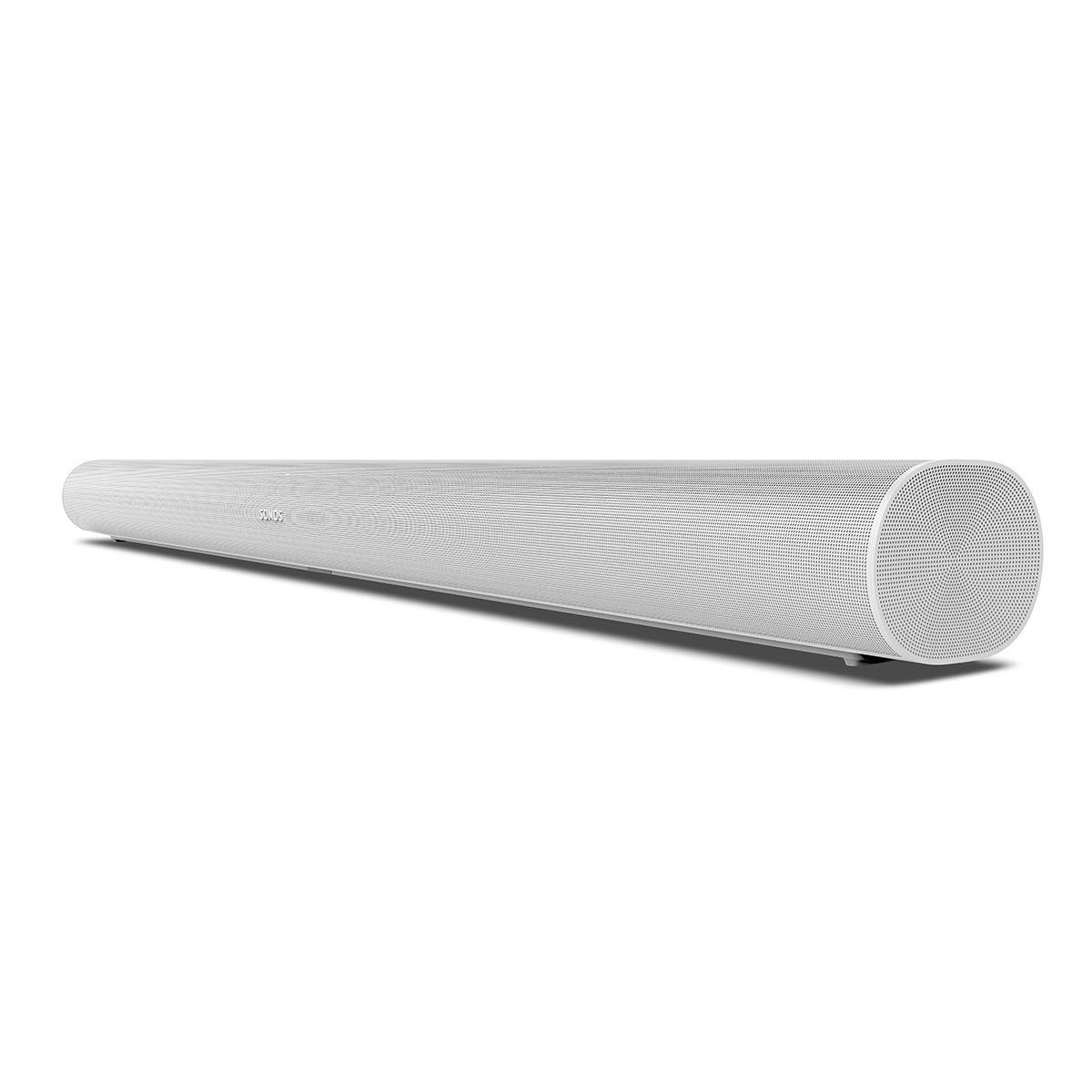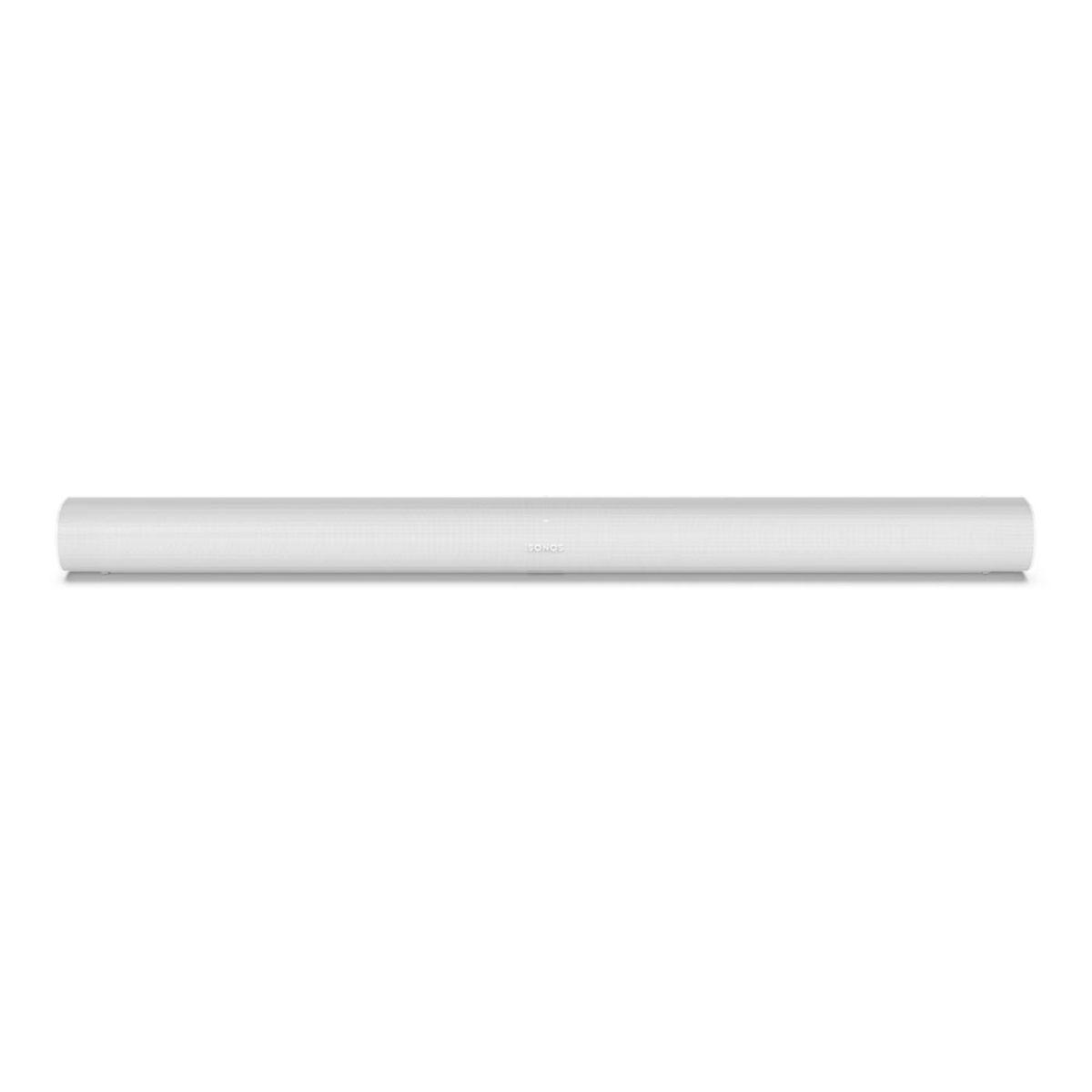
When it comes to improving your TV's audio, soundbars offer an elegant solution. Today, we're comparing the premium Sonos Arc ($564.44) with the budget-friendly Bose TV Speaker ($199.99) to help you make an informed decision.
Modern TVs have become remarkably thin, but this sleek design comes at the cost of audio quality. Their tiny built-in speakers simply can't deliver the rich sound experience that today's content deserves. This is where soundbars come in, offering significantly better audio without the complexity of a full surround sound system.
The Sonos Arc, released in 2020, represents the premium end of the market. It arrived as streaming services were expanding their Dolby Atmos content libraries, and Sonos designed it to take full advantage of this immersive audio format. The Arc uses upward-firing speakers that bounce sound off your ceiling to create a three-dimensional sound field – imagine hearing a helicopter seemingly fly overhead during a movie scene.
In contrast, the Bose TV Speaker takes a more straightforward approach. It focuses on the basics: clearer dialogue and better overall sound than your TV's speakers. Think of it as upgrading from economy to business class, while the Arc is more like first-class with all the extras.

The Arc's 11 drivers (individual speakers) work together to create a sophisticated sound stage. When watching movies, you'll notice distinct audio placement – voices come from the center, music and effects spread wide, and those upward-firing speakers create height effects. For example, during a rainstorm scene, you might hear raindrops seemingly falling from above.
The Arc's Trueplay technology uses your iPhone's microphone to analyze your room's acoustics and adjust the sound accordingly. It's like having a professional audio engineer tune your system for your specific space.
The Bose focuses on clear dialogue and balanced sound. Its dialogue mode enhances speech frequencies, making it easier to understand conversations without increasing overall volume. While it can't create the immersive experience of the Arc, it excels at its primary mission: making TV shows and movies more enjoyable than TV speakers alone.

The Sonos Arc offers extensive connectivity options. Its HDMI eARC connection supports the highest quality audio formats, including Dolby Atmos. Built-in WiFi enables streaming from services like Spotify, while Apple AirPlay 2 support lets you easily play audio from Apple devices. Voice control through Amazon Alexa or Google Assistant adds convenience – imagine saying "turn up the volume" without reaching for the remote.
The Bose TV Speaker keeps things simpler with HDMI ARC, optical, and Bluetooth connections. While it lacks WiFi and smart features, this simplicity means less potential for technical issues. Its Bluetooth connection lets you stream music from your phone, though you'll need to manually reconnect each time.
For home theater enthusiasts, the Arc presents compelling advantages. Its Dolby Atmos support and wide soundstage create a more cinematic experience. The ability to add a wireless Sonos Sub and rear speakers allows for future expansion into a full 5.1.2 surround system.
The Bose can connect to a subwoofer via a wired connection, but lacks support for rear speakers. It's better suited for everyday TV watching and occasional movie nights rather than creating a dedicated home theater experience.

In practical use, the Arc's superior technical capabilities translate to noticeable benefits. Action scenes have more impact, quiet dialogue remains clear, and music shows excellent detail. The room-filling sound works well in medium to large spaces.
The Bose performs admirably in smaller rooms, where its more focused sound signature can actually be an advantage. It particularly shines with TV shows and news programs, where dialogue clarity is paramount.
At nearly triple the price, the Arc must justify its premium positioning. For those who appreciate high-quality audio and want the latest features, it delivers. The ability to expand the system over time adds long-term value.
The Bose represents solid value for those seeking improved TV audio without breaking the bank. Its performance significantly exceeds TV speakers, and its simplicity can be an advantage for users who don't need advanced features.

Consider choosing the Sonos Arc if:
The Bose TV Speaker makes more sense if:
Both soundbars succeed at their intended purposes, but they serve different users. The Sonos Arc represents the current state of the art in soundbar technology, offering premium sound and features for discerning users. The Bose TV Speaker provides a significant upgrade over TV speakers at an accessible price point.
Your choice ultimately depends on your specific needs, room size, and budget. Either way, you'll be taking a significant step up from your TV's built-in speakers, ensuring your viewing experience matches the quality of today's high-resolution screens.
| Sonos Arc ($564.44) | Bose TV Speaker ($199.99) |
|---|---|
| Audio Channels - Determines how immersive the sound experience is | |
| 5.0.2 channels with Dolby Atmos | 2.0 channels stereo only |
| Speaker Configuration - Affects sound quality and directionality | |
| 11 drivers (3 tweeters, 8 woofers) with upward-firing | 2 full-range drivers |
| Connectivity - Important for compatibility and ease of use | |
| HDMI eARC, WiFi, Ethernet, AirPlay 2, Bluetooth | HDMI ARC, Optical, Bluetooth, 3.5mm aux |
| Smart Features - Adds convenience and future-proofing | |
| Built-in Alexa/Google Assistant, Sonos app control | Basic remote control only |
| Room Calibration - Optimizes sound for your space | |
| Trueplay automatic room tuning (iOS required) | No room calibration |
| Expandability - Important for future system growth | |
| Wireless sub and rear speakers supported | Wired subwoofer only |
| Dolby Support - Critical for modern content | |
| Dolby Atmos, TrueHD, Digital Plus, PCM | Basic Dolby Digital only |
| Size - Consider your TV and space | |
| 45" x 3.4" x 4.5" (larger TVs 55"+) | 23.4" x 2.2" x 4" (fits most TVs) |
| Multi-room Audio - Adds whole-home audio capability | |
| Full Sonos ecosystem integration | No multi-room capability |
| Voice Enhancement - Helps with dialogue clarity | |
| Advanced speech enhancement with Night Mode | Basic dialogue mode |
| Bass Performance - Important for movie impact | |
| Integrated bass with optional wireless sub | Limited bass, optional wired sub |
The Sonos Arc ($564.44) offers superior sound quality and features like Dolby Atmos, while the Bose TV Speaker ($199.99) provides basic sound improvement at a lower price. The Sonos Arc is better for those wanting premium audio, while the Bose is ideal for basic TV sound enhancement.
Yes, if you value immersive sound and smart features. The Sonos Arc offers significantly better audio quality, Dolby Atmos support, and smart features that justify its higher price for enthusiasts. The Bose TV Speaker is a better value if you just want improved TV audio.
Both perform well, but differently. The Sonos Arc uses advanced processing and dedicated center channel speakers, while the Bose TV Speaker has a specific dialogue mode. Both improve voice clarity over TV speakers, with the Arc offering more sophisticated enhancement.
Yes, but differently. The Sonos Arc works with wireless Sonos subwoofers, while the Bose TV Speaker requires a wired subwoofer connection. The Sonos offers more flexibility in subwoofer placement.
The Sonos Arc provides superior music playback with better detail and stereo separation, plus streaming capabilities. The Bose TV Speaker offers basic music playback through Bluetooth but isn't optimized for music.
The Sonos Arc requires HDMI eARC for full Dolby Atmos support, while the Bose TV Speaker works with any TV using HDMI ARC or optical connection. Consider your TV's capabilities when choosing.
The Bose TV Speaker offers simpler plug-and-play setup. The Sonos Arc requires more initial setup but offers more features once configured.
The Sonos Arc has built-in voice assistants (Alexa and Google Assistant). The Bose TV Speaker doesn't have voice control capabilities.
The Bose TV Speaker is more suitable for small rooms due to its compact size. The Sonos Arc performs better in medium to large rooms where its Atmos capabilities can shine.
Yes, both work with any TV, but the Sonos Arc needs HDMI eARC for full features. The Bose TV Speaker is more universally compatible with older TVs.
Both support Bluetooth, but the Sonos Arc also offers WiFi streaming and Apple AirPlay 2. The Bose TV Speaker is limited to Bluetooth connectivity.
The Sonos Arc provides a more cinematic experience with Dolby Atmos and superior sound quality. The Bose TV Speaker offers improved movie sound over TV speakers but lacks immersive audio features.
We've done our best to create useful and informative comparisons to help you decide what product to buy. Our research uses advanced automated methods to create this comparison and perfection is not possible - please contact us for corrections or questions. These are the sites we've researched in the creation of this article: whathifi.com - soundandvision.com - en.community.sonos.com - cnet.com - worldwidestereo.com - abt.com - creativeaudio.net - target.com - sonos.com - worldwidestereo.com - businessinsider.com - en.community.sonos.com - youtube.com - bestbuy.com - projectorscreen.com - forums.audioholics.com - digitaltrends.com - abt.com - crutchfield.com - staples.com - bestbuy.com - pcrichard.com - visions.ca - bose.com - assets.bose.com